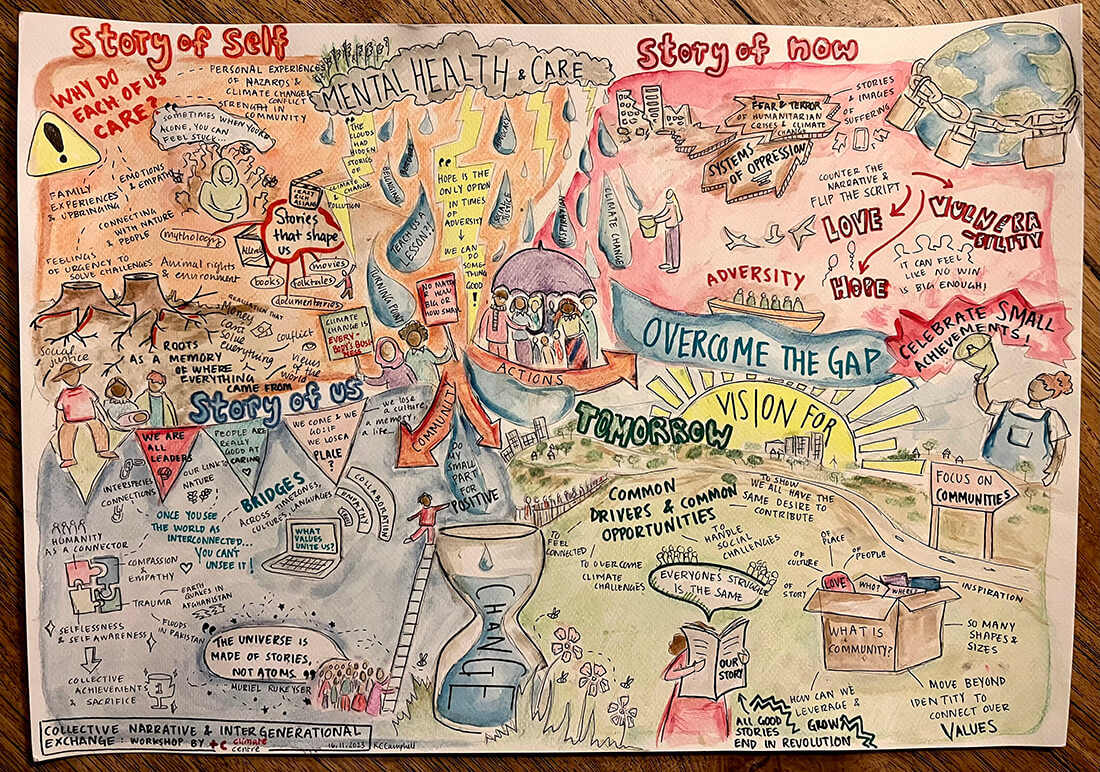We are all Storytellers: Art and Narrative as a tool for climate and humanitarian communication at the Red Cross Climate Centre
When we research, read, and report, we tell a story. Unknowingly perhaps, we set a scene, locate characters and map out their journeys, setbacks and victories. Whether it be for disasters, insecurity, humanitarian crises or climate impacts, it is no different; we are storytellers, and these stories have power. They can connect, bridge divides, share knowledge, engage and prompt action… The opportunities dignified and representative stories can offer are endless.

by Raramai Campbell
Raramai is a former MSc Global health student at University of Copenhagen. She specialised in Disaster Risk Management as part of her studies and now works as a consultant at The Alliance of Bioversity International and CIAT as part of their Climate Security team in their Southern Africa hub in Pretoria.
“The world is made of stories, not atoms”
These words by Muriel Rukeyser opened the Collective Narrative and Intergenerational Exchange workshop hosted by Red Cross Red Crescent Climate Centre that I supported through visual notes. These words, I feel, also set the tone for the work I was part of at the Climate Centre as a junior researcher in their Climate and Conflict team.
When we research, read, and report, we tell a story. Unknowingly perhaps, we set a scene, locate characters and map out their journeys, setbacks and victories. Whether it be for disasters, insecurity, humanitarian crises or climate impacts, it is no different; we are storytellers, and these stories have power. They can connect, bridge divides, share knowledge, engage and prompt action… The opportunities dignified and representative stories can offer are endless; this is what creating live art and visually documenting people’s stories of humanitarian and climate crises for the workshop showed me. Regardless of background, experience or age, there is often more that links us than divides us: similar concerns and similar ideas of where we can go from here.

We drew on Ganz’s (2009) framework of public narrative to map out stories of self, us and now, and because it’s just as important, we added: visions for the future. This exercise, while simple was one of the ways the Climate Centre makes issues like the impacts of climate change and conflict - which can seem remote and distant to some, or closer to home for others, relatable to all.
As part of the team, I worked to ‘translate’ technical climate and conflict knowledge to make it more accessible and engaging. One example of this was an ArcGIS Storymap that I designed with others on the team to capture our ongoing research on anticipatory action for floods in conflict affected areas of Mali. We conducted interviews with stakeholders, did deep dives into policy and explored flood exposure and conflict maps with the aim of documenting it all in a research paper, but also, as an interactive Storymap (Find it here). The Storymap gave us the opportunity to integrate art, Malian music and videos from the flood response to make the case more tangible and reflect real life experiences.
Being inspired by others on the team to use creativity and new tools like Storymaps, unlocked a world of art, advocacy and action-oriented research – three things I’m passionate about and didn’t quite know how to combine till now. I was able to collaborate with colleagues at the Climate Centre, IFRC, the Danish Red Cross and Malian Red Cross to learn about conflict sensitive anticipatory action and figure out perhaps most importantly, how to represent it all in stories for the rest of the world to be part of.
A Collaboration between COPE, The Danish Red Cross and the Climate Centre.
Do not forget to check out the StoryMap on Anticipatory action for floods in conflict-affected Mali. A map-based complement for the flood early action protocol (EAP) activation in Sofara, Mopti Region Mali in 2022
